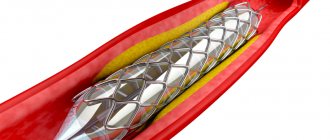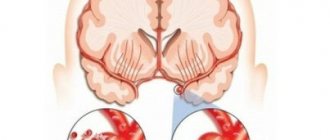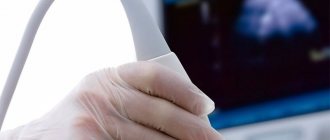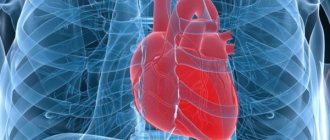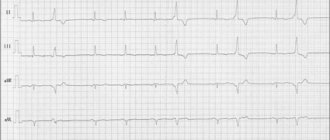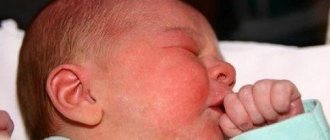CLASSIFICATION of cardiac arrhythmias
(V.L. Doshchitsin, 1991).
I. Impairment of impulse formation.
1. Sinus tachycardia. 2. Sinus bradycardia. 3. Sinus arrhythmia. 4. Migration of the rhythm source. 5. Extrasystole: a) suprapentricular and ventricular; b) single, group, allorhythmic. 6. Paroxysmal tachycardia: a) supraventricular and ventricular; b) paroxysmal and constantly recurrent. 7. Non-paroxysmal tachycardia and accelerated ectopic rhythms - supraventricular and ventricular. 8. Atrial flutter: a) paroxysmal and persistent; b) regular and irregular shapes. 9. Atrial fibrillation: a) paroxysmal and persistent; b) tachysystolic and bradysystolic forms. 10. Flickering (fibrillation) and ventricular flutter.
II. Conduction disorders.
1. Sinoatrial blockade—complete and incomplete. 2. Intraatrial block - complete and incomplete. 3. Atrioventricular block: a) I, II and III degrees; b) proximal and distal. 4. Intraventricular block: a) mono-, bi- and tri-fascicular, focal, arborptic; b) complete and incomplete.
III. Combined arrhythmias.
1. Sick sinus syndrome. 2. Escaping (slipping) contractions and rhythms - supraventricular and ventricular. 3. Syndromes of premature excitation of the ventricles. 4. Parasystoles. 5. Long QT syndrome.
Classification of ventricular extrasystole
(Lown, 1983).
1 tbsp. - single, rare monotonous extra-tables, no more than 60 per 1 hour (no more than 1 per 1 minute). Stage 2—frequent—monotopic extrasystoles, more than 1 per minute. 3st. - polytopic, frequent ventricular extrasystoles. 4st. - group ventricular extrasystoles (double and volley). 5th stage - early extrasystoles, type “R” to “T” and extra early.
3-5 tbsp. - these are extrasystoles of high gradation, indicate myocardial damage, are prognostically unfavorable (can develop into more serious rhythm disturbances).
With ischemic heart disease, almost all of the listed cardiac arrhythmias are possible, usually in combination with other manifestations of the disease: angina pectoris, myocardial infarction, heart failure. Thus, in the acute period of myocardial infarction, rhythm disturbances are recorded in almost all patients. 60-80% of patients with coronary artery disease die suddenly due to ventricular fibrillation (E. Chazov, 1985; Lown, 1983).
Procedure for conducting the examination
The survey is carried out by specialists who are members of the bureau. In addition, the commission may include representatives of the employment service and other extra-budgetary funds.
The examination includes an examination of the patient’s condition, analysis of the attached documentation, clarification of the patient’s living conditions and other information. The decision is made by the members of the commission during voting. In this case, an ITU act is drawn up.
Survey
As a rule, in case of vascular and heart diseases, disability is given for a period of 12 months. Therefore, patients should undergo regular examination. Sometimes a person may be denied extension of disability. If the patient does not agree with the decision of the commission, he can appeal this decision within 30 days to the ITU bureau. To resolve particularly controversial issues, you can turn to the courts.
Diagnostic methods
1. ECG at rest and during dosed physical activity (VEM).
2. Daily (Holter) monitoring. Indications:
— patient complaints of heart rhythm disturbances not documented by ECG; — identification of asymptomatic arrhythmias in individuals at high risk of their occurrence (hypertrophic cardomnopathy, aortic stenosis, etc.); — examination of the working capacity of persons engaged in professions related to the performance of work, the sudden cessation of which could harm others (pilot, dispatcher, driver, etc.); - syncope of unknown origin.
3. EPI - transesophageal. 4. Endocardial EPI and programmed electrical stimulation of the heart.
Indications:
- repeated episodes of ventricular fibrillation; - severe attacks of ventricular tachycardia; - frequent and severe attacks of supraventricular tachycardia; - syncope of presumably arrhythmic origin; — indications for surgical treatment of arrhythmias; — selection of drug antiarrhythmic therapy.
TREATMENT
Drug treatment
.
Classification of antiarrhythmic drugs:
Group I (membrane stabilizing agents) A: quinidine, novocainamide, etc.; B: Lidocaine, diphenylhydantoin; C: ajmaline, ethmoznn, etacizin, allapinin. Group II (beta-blockers). Group III (drugs that slow down repolarization): amiodarone, bretylium tosylate. Group IV (calcium antagonists): verapamil, nifedipine.
Any antiarrhythmic drug can cause both antiarrhythmic and arrhythmogenic effects. The probability of an antiarrhythmic effect for most drugs is on average 50% and very rarely, only in a few clinical forms of arrhythmias, reaches 90-100%: a) relief of reciprocal atrioventricular tachycardia using intravenous administration of ATP, adenosine or verapamil; b) relief and prevention of paroxysmal tachycardia with complexes such as right bundle branch block and sharp deviations of the heart axis to the left with the help of verapamil; c) elimination of ventricular extrasystole with etacizine, flecainide.
In all other cases, the selection of antiarrhythmic therapy will be done by trial and error. In this case, the probability of an arrhythmogenic effect is on average 10%, in some cases life-threatening for the patient. The more severe the rhythm disturbances and the degree of myocardial damage, the higher the risk of an arrhythmogenic effect. Therefore, at present, most researchers believe that for asymptomatic and low-symptomatic arrhythmias, as a rule, the prescription of antiarrhythmic drugs is not required (A. S. Smetnen et al., 1993).
If drug therapy is necessary, the selection of antiarrhythmic drugs is based on the nature of the rhythm disturbance.
Supraventricular rhythm disturbances
1. Acute (extrasystole, paroxysmal atrial fibrillation, atrial flutter): procainamide, quinidine; (paroxysmal tachycardia): physical methods, isoptin, ATP, beta-blockers. 2. Prevention of paroxysms: cordarone, quinidine, beta-blockers.
Ventricular arrhythmias
1. Acute (extrasystole, paroxysmal tachycardia, fibrillation): lidocaine, nonocainamnd, etacizium, cordarone. 2. Prevention of paroxysms: cordarone, quinidine, diphenylhydantoin, novocainamide.
Special forms of rhythm disturbance:
1. WPW syndrome: cordarone, ethmozin, gilurythmal (ajmalin). Contraindicated: cardiac glycosides and partially isoptic. 2. Sick sinus syndrome: rhythmylene, quinidine (under control of sinus node activity).
Non-drug treatments
1. Electrical defibrillation. 2. Electrical stimulation of the heart.
Surgery
1. Intersection of additional pathways. 2. Removal, destruction or isolation of arrhythmogenic foci in the heart. 3. Cardiac stimulation (permanent, temporary). 4. Destruction of the atrioventricular node with implantation of a pacemaker.
Disability after heart surgery
Heart surgery is a radical method of treatment, which is prescribed if the patient is in critical condition and all possible drug treatment has not led to positive dynamics. In most cases, after cardiac surgery, the patient is assigned to one of the disability groups.
After bypass
Bypass surgery is the creation of an additional path bypassing the affected area of any vessel or pathway of the body using cavity plastic modeling surgery.
To determine the disability group, specialists take into account the following factors:
- response to coronary artery bypass surgery, body reaction,
- For what indications was the operation performed and whether there were other diseases.
If persistent negative changes are identified, disability can be assigned for life, but in most cases it is assigned for a couple of years. Subsequently, the patient undergoes re-examination, which can either change the group or remove it completely.
After valve replacement
Replacing a valve cannot always completely eliminate all heart problems, and the issue of disability is decided in each specific case on an individual basis. The patient undergoes an examination, and in accordance with its results, specialists determine the degree of so-called wear and tear of the heart muscle. If there are signs of CHF, this may be a reason for transferring the patient to easier working conditions or receiving disability.
After ablation
Radiofrequency catheter ablation is a surgical treatment for arrhythmias. This includes a number of methods in which the source of arrhythmia (pathological pathways) is destroyed by heating using electric current.
Not long ago, after ablation, group 2 was prescribed. It was given for a period of 1 year. Nowadays, thanks to modern surgical capabilities, the operation has become significantly simplified, therefore, the recovery period has also become simpler and shorter. The decision to assign a disability group to a patient is made based on the form and degree of disruption of the blood supply to organs.
With NK 1st degree, disability is not provided, with NK 2nd degree, 2nd group is provided, and with NK 3rd degree, 1st disability group.
ITU UNDER NDS IS DETERMINED BY THE FOLLOWING MAIN FACTORS
a) the severity of rhythm disturbances; b) the nature of the disease that caused the rhythm disturbances; c) the presence of contraindicated working conditions; d) the nature of the treatment (medicinal, surgical).
Severity of heart rhythm disturbances
The severity of heart rhythm disturbances is determined by: a) the frequency of their occurrence (paroxysmal form);
b) duration (paroxysmal form); c) hemodynamic state; d) actual and probable complications: heart failure (acute and chronic); acute coronary insufficiency or progressive chronic; acute cerebrovascular insufficiency or progressive chronic; thromboembolic complications; syncope or sudden death. In terms of assessing work capacity, it is inappropriate to separate different forms of NSR and conductivity according to their severity and prognostic significance.
1. Mild degree
(insignificant NSR and conductivity): supraventricular and ventricular extrasystoles (I-II gradations according to Lown); brady- or normosystolic constant form of atrial fibrillation; sick sinus syndrome with a rhythm frequency of more than 50 per minute; paroxysms of atrial fibrillation and supraventricular tachycardia, occurring once a month or less, lasting no more than 4 hours and not accompanied by subjectively perceived changes in hemodynamics; A-B blockade of the 1st degree and 2nd degree (Mobitz type I); mono- and bifascicular blockades of the branches of the His bundle.
2. Moderate severity.
Polytopic frequent (1: 10) ventricular extrasystole (III gradation according to Laun); paroxysms of atrial fibrillation, atrial flutter; supraventricular tachycardia, occurring 2-4 times a month, lasting more than 4 hours, accompanied by changes in hemodynamics felt by patients; conduction disorders: A-B Mobitz block II and III degrees, tri-fascicular block of the branches of the His bundle, sick sinus syndrome, sinoauricular block III degree, junctional rhythm with a heart rate of more than 40 per minute and the absence of HF.
3. Severe degree.
Ventricular extrasystole - frequent polytopic, volley, early (IV-V gradation according to Laun);
paroxysms of atrial fibrillation, atrial flutter, supraventricular tachycardia, occurring several times a week, accompanied by pronounced changes in hemodynamics, difficult to tolerate by patients; paroxysms of ventricular tachycardia; a permanent form of atrial fibrillation, tachysystolic atrial flutter, not corrected by medications and accompanied by progressive heart failure; sick sinus syndrome, trifascicular His bundle block, Frederick's syndrome with heart rate less than 40 per minute, attacks of MES and syncope, progressive heart failure. Functionally significant deterioration of hemodynamics as a result of rhythm and conduction disturbances, the emergence or increase in the severity of heart failure is determined not only by the form of NSR, but also by the initial state of the myocardium (cardiosclerosis) and coronary and cerebral arteries (atherosclerosis).
Thromboembolic complications, syncope and sudden death can occur when NSR and conduction are the only manifestation of the disease: congenital anomalies of the cardiac conduction system; isolated damage to the artery supplying the sinus node, isolated focal cardiosclerosis involving the conduction system of the heart, non-progressive hypertrophic cardiomyopathy.
Contraindicated working conditions
1. Working conditions contraindicated in case of the underlying disease that caused NSR and conductivity (IHD, rheumatism, and others).
2. The presence or risk of ventricular arrhythmias and asystole: work that poses a danger to others and the patient in the event of its sudden cessation (driver, pilot, railway and aeroflot dispatcher, work at height and in extreme conditions). In most cases of NSD, the ability of patients to work is determined by the underlying disease that was their cause. Difficulties in MSE, as a rule, arise more often when the only manifestation of the pathological process is a violation of rhythm and conduction.
Able-bodied
1. Insignificant (mild) rhythm disturbances.
2. Average severity of rhythm disturbances with the exception of contraindicated labor factors. Reduced ability to work (limited ability to work - disability group III): 1. Severe degree of rhythm disturbance. Heart rhythm and conduction disturbances, as a rule, do not have independent significance in permanent disability and are considered in combination with the underlying disease that caused their occurrence. It should be taken into account that NSR and severe conduction may contribute to the progression of heart failure and indicate a high risk of sudden death.
The greatest difficulties arise when it is necessary to assess the ability to work and rationally employ patients with continuous electrical cardiac stimulation (PECS).
This method is currently widely used for the treatment of the following NSR and conduction: acquired complete A-B block in the presence of MES attacks and a heart rate of less than 40 beats per minute; congenital permanent A-B block with a heart rate less than 50 beats per minute; A-B blockade of the second degree (Mobitz II); blockade of both bundle branches; sick sinus syndrome, tachybradcardia syndrome; supraventricular paroxysmal tachycardia and atrial fibrillation, resistant to drug therapy; WPW syndrome.
Instructions: how to apply for disability
New rules for obtaining disability have made the examination procedure simpler. Now the medical organization independently transmits the referral to the ITU electronically; citizen participation in the process is not necessary. The procedure became possible with the adoption of Government Resolution No. 607 of May 16, 2019. The Ministry of Labor of the Russian Federation, in letter No. 13-4/10/B-4132 dated May 29, 2019, explained the provisions of the new regulatory act.
Let's look at getting disability in 2021 step by step, taking into account the new rules.
Step 1. Receive a referral to ITU or a certificate of refusal to be sent to ITU.
A referral, subject to the consent of the person in writing, is issued:
- by a medical institution upon implementation of a set of measures, despite which persistent impairment of body functions persists;
- Pension Fund or social security - in the presence of documents that confirm deviations in functions due to illness, injuries, defects.
The referral to the ITU is transmitted to one of the specified organizations via electronic communication channels, or, if there are none, on paper.
Upon receipt of a refusal, a person is issued a certificate, in the presence of which he applies to the ITU independently.
Step 2. Prepare the required documents.
The following documents are required to complete the procedure:
- consent of the person in writing to conduct MSE;
- ID card or its certified copy;
- document proving the identity and authority of the representative (if the application is made through a representative);
- referral to ITU or certificate of refusal in such a referral;
- application for an ITU (when a citizen is issued a certificate of refusal to be referred to an ITU);
- medical documents that make it possible to establish the causes of disability;
- medical documents to determine the degree of loss of ability to work;
- conclusion of the medical commission of a medical organization confirming that for health reasons the citizen is not able to come to the MSA office, and therefore he requires MSA at home.
Step 3. Wait for the invitation to the ITU.
There is no longer any need to contact ITU. After receiving documents from the medical organization, the ITU sends an invitation to the patient, which indicates the date, time, and place of the examination.
Step 4. Go through the ITU and get a solution.
ITU pass:
- at the ITU bureau at the place of residence (place of stay), location of the pension case;
- at home if it is impossible to attend due to health;
- in a medical institution where the person is hospitalized;
- in the organization of inpatient social services;
- in a correctional facility;
- in absentia - by decision of the bureau.
Step 5. Obtain a certificate of disability and IPR.
A certificate confirming the established disability and IPR (rehabilitation program) is sent to:
- by registered mail;
- through the government services portal.
Indications for referral to MSE for patients with implanted pacemakers
To extend the duration of VUT in cases of effective pacemaker implantation and a favorable clinical and labor prognosis with: - the presence of complications in the postoperative period (pleurisy, pericarditis, etc.);
- heart rhythm disturbances of moderate severity (for example, ventricular extrasystole more than 6-8 per minute, parasystole, etc.), requiring active and long-term drug therapy; — presence of signs of the initial stage of heart failure; disorders of psychological adaptation to ECS requiring psychotherapeutic correction. 2. To determine the disability group for persons of working age: - the presence of absolute medical contraindications to the continuation of the previous professional activity and the need, in connection with this, to transfer to another job with a reduction in volume, qualifications or a change in profession; — ineffectiveness of PEX, as a result of which attacks of NSR and conduction persist, which is accompanied by significant dysfunction of the cardiovascular system; — presence of complications of PEX requiring long-term treatment; - absolute dependence of the patient on PEX; - worsening of the underlying disease.
3. Re-examination of disabled people with PEX.
The required minimum of research when referring a patient for medical examination.
The required amount of research is determined by the underlying disease and includes: a) the results of a study of the degree of dependence of the patient on the pacemaker; b) ECG at rest; VEM test (threshold power - 75 W); c) daily monitoring (according to indications); d) integral rheography or echocardiography; e) chest x-ray; f) consultation with a psychotherapist.
Contraindicated working conditions (absolute):
1. Work associated with being in conditions of strong static charges, magnetic fields and pronounced effects of microwave fields.
2. Work related to electrolytes and under conditions of exposure to strong induction of thermal and light radiation from stoves and radiators. 3. Work related to the maintenance of existing powerful electrical installations. 4. Work in conditions of severe vibration. 5. Work associated with constant or episodic significant physical stress throughout the entire working day, at a prescribed pace, and in a forced body position. 6. Work associated with potential danger to others due to its sudden cessation by patients. Patients should be considered able to work if they are effectively treated with a permanent pacemaker: the disappearance of previously existing PSR and conductivity, significant or complete regression of HF phenomena, and the absence of complications in the postoperative period. As a result, in such patients, after 1.5-2 months, the quality of life improves, a normal psychological reaction is established, the required level of physical activity is achieved, and they can resume their professional activities in professions of mental or light physical labor.
A necessary condition for the restoration of working capacity is the patient’s independence from the pacemaker: the emergence of his own heart rhythm after suppression of the pacemaker.
Legislative basis for establishing a disability group
The disability group is assigned based on the results of the ITU assessment of the degree of limitations in life activities due to disorders of body functions. The procedure is regulated by law and regulations of the Ministry of Labor and the Ministry of Health.
The conditions under which a person is recognized as disabled are listed in the table.
| Index | Signs |
| Health condition is impaired | Persistent impairment of body functions due to illness, injury, or defects |
| Life activity is limited | Complete or partial loss of ability:
|
| Need for social support | The need for rehabilitation or habilitation measures |
The presence of one of the listed indicators is not a sufficient basis for assigning the status of “disabled person”.
The Ministry of Labor, in letter No. 13-4/10/B-4132 dated May 29, 2019, explains the rules by which a person is sent for and passes the ITU examination. In addition, obtaining disability under the new law in 2021 is regulated by a number of regulations, including:
- Federal Law No. 181-FZ of November 24, 1995;
- Government Decree No. 95 of February 20, 2006;
- Government Decree No. 607 of 05/16/2019;
- Government Decree No. 92 of 02/01/2021;
- Order of the Ministry of Labor No. 1024n dated December 17, 2015.
Disability criteria
III group:
after the operation, there is an improvement in the general condition of the patients, but they have: a) a positive VEM test;
b) moderate disorders of the circulatory system; c) the presence of a persistent psychopathological reaction to pacemaker implantation with personality changes; d) the need for employment in non-contraindicated working conditions, with a decrease in the volume of production activities, qualifications or a change in profession. Group II:
ineffectiveness of surgical treatment using the PEX method:
a) previous NSR and conductivity are preserved; b) interference of ECS and own rhythms; c) pronounced manifestations of coronary and heart failure (angina pectoris class III—IV, heart failure stage IIB—III); d) absolute dependence on the ECS.
What diseases give disability?
Assignment of disability occurs when there is a persistent impairment of health, which causes disruption of the functioning of internal organs. The list of heart diseases eligible for the group includes:
- severe congenital heart disease (congenital heart disease), extreme circulatory disorder;
- myocardial infarction, causing insufficient blood supply to tissues and organs, provoking a functional cardiac disorder, necrosis of the myocardial muscle. Which leads to the physical inability of patients to perform work activities. Usually the disease progresses against the background of coronary heart disease and smoking;
- third stage hypertension, accompanied by frequent crises, increased blood pressure (blood pressure), which negatively affects the blood supply to brain tissue and causes paralysis.
Disability is also due after complex heart surgery. That is, if the patient has undergone valve replacement, bypass surgery, or vascular stenting. A more detailed list of diseases can be obtained from your attending physician.
